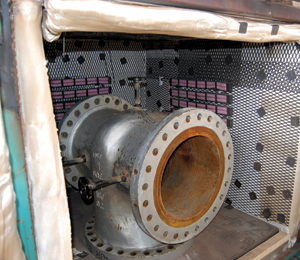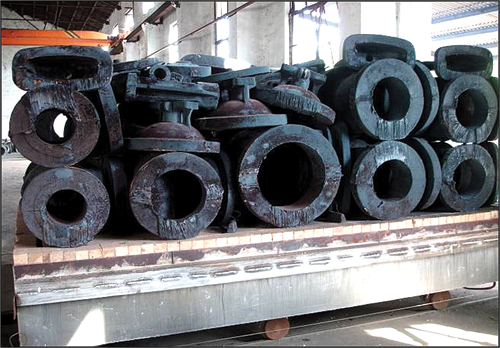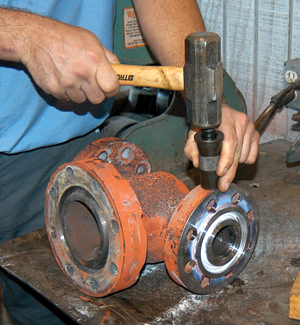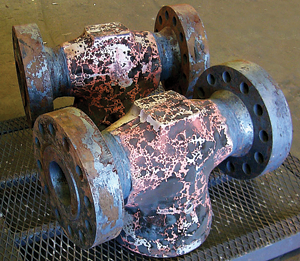Actually, while the industry is certainly formidable, its products are made of steel, iron and a host of other metals and alloys, all of which are used to construct valves, actuators, flanges, fittings and pipes used in commercial and industrial piping systems. These materials and parts also get a little help—the components would not be able to do their job of controlling pressure, resisting temperature and fighting corrosion if the metals they are made of weren’t made even better by being properly processed to meet the challenges. This is where heat treatment comes in—it’s the sidekick that makes our superhero materials more effective.
Aside from some “as-cast” cast irons, the vast majority of metallic valve materials require some form of heat treatment to attain the properties needed to meet their purposes.
WHAT IT IS
This initial process of thermal creation normally does not yield metals with the most desired mechanical properties. After the initial cooling phase, these metals are “put back in the oven,” for a little more cooking to refine their properties. This secondary thermal processing is referred to as heat treatment.
The general definition is: “the controlled heating and/or cooling which is intended to improve certain properties of metals.” Some of these treatments will harden and strengthen metals, while others will soften or make metals easier to machine or shape. Still other heat treatments will reduce the residual stresses caused by welding or forming. While most heat treatments are performed at elevated temperatures, some specialized heat treatments are performed at cryogenic temperatures.
The primary mechanical properties affected by heat treatment include hardness, ductility, strength and toughness. These are:
- Hardness: A measure of the resistance of a metal to scratching or indentation. A variety of hardness tests are used to measure this property.
- Ductility: The ability of a metal to deform permanently prior to fracture or failure. The elongation or reduction-of-area, tensile-pull-test of a round sample is used to quantify this property.
- Strength: When considering most valve components, two essential measures of strength are used: The first is yield strength (YS), which is the measure of strength before a metal permanently deforms. The second is tensile strength or “ultimate tensile strength” (UTS), which is the maximum strength a metal exhibits before failure or permanent deformation.
- Toughness: This is a less scientific term, but it combines strength and toughness. Toughness is an extremely important property for metals used at low temperatures. The Charpy Impact Test is one of the methods used to measure a metal’s toughness at various temperatures.
CARBON STEELS
Forgings, castings and welding are all processes used to make valves and valve components. Nearly all these processes require some form of heat treatment. Since low-carbon steels (steels with a carbon content of about 0.030% or less, such as WCB and A105) constitute much of total valve population, the correct heat treatment for this material is worth discussion.
Carbon steels are a mixture of iron and carbon. This mixture exists as a microscopic structure of grains visible only under a high-powered microscope. These grains align themselves in different configurations known as “grain structures,” such as austenite, ferrite, martensite and bainite. The presence and percentage of each of the grain structures help determine the mechanical properties of steels and their alloys.
These grain structures can be altered through heat treatment. This means that a steel of a specific chemistry can be heat-treated to yield grades of steel with various levels of strength, ductility or hardness. To alter the grain structure, the steel must be heated to within a very specific temperature range, called the “transformation range,” for grain structure changes to occur. Some heat treatment temperatures even exceed the transformation range.
Let’s consider the most common valve cast steel in use today, ASTM A216 grade WCB. As cast, even with the correct chemistry, the microstructure of the steel would be so poor that the casting is useless for pressure-containing applications. However, the A216 specification requires the castings be delivered in one of the following heat-treated conditions: 1) annealed, 2) normalized, 3) normalized and tempered, or 4) quench and tempered. Proper heat treatment will convert the as-cast material into a highly useful valve component.
Some of the more important heat treatment processes used in valves and the valve industry are annealing, quenching, tempering, normalizing and stress relief. Definitions of some of the different heat treatment processes as given in ASTM A961, Standard Specification for Common Requirements for Steel Flanges, Forged Fittings, Valves, and Parts for Piping Applications are:
- Annealing: Material shall be uniformly reheated to a temperature above the transformation range and, after holding for a sufficient time at this temperature, cooled slowly to a temperature below the transformation range.
- Normalizing: Material shall be uniformly reheated to a temperature above the transformation range, and subsequently cooled in air, at room temperature. (This is a faster cooling rate than that of annealing.)
- Quenching and Tempering: Material shall be fully austenitized and quenched immediately in a suitable liquid medium. The components are then reheated to a minimum temperature of 1100°F (593°C) and allowed to cool in still air.
- Post-Weld Heat Treatment and Thermal Stress Relief: Material shall be reheated to the prescribed temperature below the transformation range, held at temperature for at least one hour per inch of thickness and allowed to cool in still air. (The exact time and temperature requirements are listed in various piping standards and construction codes.)
- Solution Annealing: Material shall be heated up to a temperature that causes chrome carbides to go into solution and then quenched in water or rapidly cooled by other means to prevent precipitation. (This process is often used with austenitic stainless steels such as 316ss to help maintain the corrosion resistance of the component.)
The austenitic stainless steels, especially the 300 series, usually receive a solution-annealed heat treatment at between 1900°F (1038°C) and 1950°F (1067°C), depending upon the specific alloy. High nickel alloys and “superalloys” also receive a variety of heat treatments with names such as age-hardening, precipitation hardening and others, specific to their chemistry and desired mechanical properties.
410SS AND HEAT TREATMENT
When it comes to valve components, the combination of martensitic stainless steels (410ss) and heat treatment has been and still is, an all-around winner. The air-hardenable, 13% chrome (Cr), 400 series martensitic stainless steels have been the material of choice for linear valve trim for nearly 75 years. The magic of the martensitic stainless steels comes from the heat-treating process, which can provide components harder than cobalt-based Stellite or as soft as plain carbon steel, depending on the chosen heat treatment.
Martensitic stainless-steel stems with a hardness range of 200 to 275 Brinell Hardness Number (BHN) are in more valves in refinery service than any other material. Seat rings or discs of 400 series stainless steel are extremely popular as well. As an aside: Most of the cutlery in your kitchen drawer is probably manufactured out of heat-treated 400 series stainless steel.
Heat treatment of castings, forgings and many weldments is usually accomplished in ovens or furnaces. These vessels are designed for batch processing and can hold loads ranging from a few pounds to many tons. Heat treatment furnaces must be calibrated to ensure the prescribed hot air temperature is evenly distributed throughout the furnace. The calibrations are called furnace surveys and are a quality requirement of any organization performing heat treatment operations. Modern furnaces may be powered by either electricity or gas, while in the old days, coal or coke-heated furnaces were used.
If a furnace has improper heat distribution from poor heated air-flow design or leaky walls and doors, the heat treatment may not be performed uniformly on all pieces in the furnaces. Also, the parts put into the furnace must be laid out in such a way as to allow free air flow around all the pieces. Failure to meet either of these requirements can yield parts without the proper mechanical properties. To ensure the heat treatment was correctly performed, test bars are usually heat treated with the actual parts batch and then subjected to various non-destructive or destructive testing techniques.
Improper heat treatment of castings has been an issue with some foundries in low-cost manufacturing countries. These improper heat treatments have resulted in a host of metal failures and components with incorrect mechanical properties over the last 25 years. Still, the heat treatment process in these locations has improved significantly in the last several years.
WELDING AND POST-WELD TREATMENT
Welding is a thermal process similar to casting in which metal is melted and deposited on or attached to another workpiece. This melting process, in the best case, can induce great stresses within the microstructure of the weld and heat-affected zone (HAZ—the area adjacent to the weld deposit). At worst, the process changes the microstructure of the HAZ. To alleviate this unwanted stress or change the microstructure of the HAZ back to what it should be, a heat treatment called post-weld heat treatment (PWHT) is performed.
PWHT is important in the valve industry because parts are often welded in the process of valve construction and because some valves are welded to other piping components. The plain low-carbon steels such as A105 and WCB usually do not require PWHT when welding to them, depending upon the thickness of the pieces to be welded.
A common operation in linear valve construction is the welding of seat rings into valve bodies. Depending upon the seat ring base material and valve body thickness, there may be no need for PWHT. However, in some cases, such as welding solid 400 series (martensitic) seat rings into valve bodies, a PWHT is recommended.
Another common operation is the welding of pipe “pups” onto the ends of valves. Pipe pups are short sections of pipe attached to the butt-weld or socket-weld ends of valves to allow them to be welded onto the pipeline itself without the risk of field welding directly onto the valve. Depending upon the pipe and valve material, thickness of the pipe and specific customer requirements, these welds may require a PWHT.
Generally, welds on low-carbon steel, non-pressure containing parts (such as brackets, yokes or actuator attachments) of a valve do not warrant any PWHT.
One situation in which PWHT is strongly recommended is when hydrogen sulfide (H2S) is present in the fluid stream. Although plain low-carbon steels can work fine in this service, large thickness welds should receive a PWHT, depending upon the degree of H2S exposure. Guidance for the PWHT of welds is contained in National Association of Corrosion Engineers (NACE) international documents MR01-75 and MR01-03. These documents are both now jointly administered and updated by NACE and the International Organization for Standardization (ISO).
For valves in H2S refinery service that contain 410ss components, added PWHT in the form of an additional tempering heat treatment is required to avoid the creation of hard areas in the weld deposit and HAZ. The requirements for these heat treatments are detailed in NACE MR01-03. The requirements for valves in upstream and midstream H2S are detailed in NACE MR01-75. They are similar to those in MR01-03.
The default for many valve manufacturers and valve service companies providing valves for H2S service is to be conservative and PWHT all welds attached to pressure-containing components or in the flow stream on carbon steels. Additionally, 400 series stainless-steel stems should receive an additional tempering heat treatment.
PWHT AND CHROME/MOLY ALLOYS
Chrome/molybdenum (Cr/Mo) alloys are steels designed for use at temperatures and pressures higher than what low carbon steels (such as WCB and A105) are designed to be used. The additions of chrome and molybdenum to the steel improve some of the properties of the steel. If thermal processes such as welding or forming are performed during or after initial manufacturing, additional heat treatment may be required. In general, the higher the chrome content of the low-alloy steel, the more intense of a post-weld heat treatment or stress relief is required.
LOCALIZED PWHT
In addition to furnaces, some heat treatments are performed using localized heat treatment methods. These processes typically use flexible ceramic blankets held together with high-temperature, heat-conducting wire. The blankets can be positioned around local areas requiring PWHT in the field without overheating other areas of the valve or piping.
When properly insulated, these blankets can produce temperatures required to easily PWHT carbon steel, martensitic stainless steel and Cr/Mo weldments. The ability to perform field heat treatment is a boon and a timesaver during processes and power-plant-welded piping fabrication.
STANDARDS AND SPECIFICATIONS
Heat treatment must be performed correctly to achieve desired mechanical properties. To this end, standards and specifications must be followed. For valve and piping parts and components, specific heat treatments are referenced in the base material specification, such as ASTM A216 or A217. However, the exact heat treatment procedure is often left up to the foundry or sub-contracted heat treatment vendor.
When it comes to welding PWHT, several standards can be referenced. For piping in the power industry, the requirements are listed in the American Society of Mechanical Engineers (ASME) B31.1, Power Piping design code. For refinery or chemical plant piping, the requirements are listed in ASME B31.3, Process Piping. The ASME Boiler and Pressure Vessel Code, Section VIII, also lists PWHT requirements that may be applied to valves.
American Petroleum Institute (API) has created a new standard in its Quality Committee 20 for manufacturers that are performing or subcontracting heat-treating services. The document, API 20H, Heat Treatment Services−Batch Type for Equipment Used in the Petroleum and Natural Gas Industry, has extensive quality and procedural requirements for companies performing heat treatment. The 20H document has four heat treatment specification levels that are used to qualify heat treatment operations.
In the 19th century, heat treatment was referred to as an art, with the heat treater or foundryman relying on his experience to add a bit of this and a bit of that to “magically” create the proper metal with the desired properties. Today, heat treatment is a repeatable scientific operation, one that is of critical importance in creating metallic valve components with the proper mechanical properties. Although there is no magic wand or even a red cape involved, the process of heat treatment and the way it works is still pretty amazing.
GREG JOHNSON is president of United Valve (www.unitedvalve.com) in Houston. He is a contributing editor to VALVE Magazine, a past chairman of the Valve Repair Council and a current VRC board member. He also serves as chairman of the VMA Communications Committee, is a founding member of the VMA Education & Training Committee and is past president of the Manufacturers Standardization Society. Reach him at greg1950@unitedvalve.com.
RELATED CONTENT
-
Hardfacing for Valves: Materials and Processes
Valve internals, such as seats and closures, are often at risk of erosion, abrasion, corrosion, galling and damage from cavitation.
-
New Technologies Solve Severe Cavitation Problems
An advanced anti-cavitation control valve design enabled by 3D metal printing solved a power plant’s severe cavitation problem and dramatically improved its bottom line.
-
Metal Additive Manufacturing: the Evolving Road to Adoption and Standardization
Greater knowledge and acceptance of metal AM valve components—especially with various standardization efforts underway—will spur the technology’s growth.












 Unloading large gate valve.jpg;maxWidth=214)


